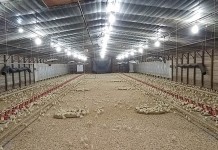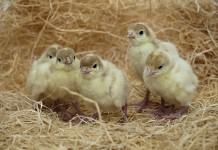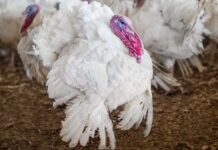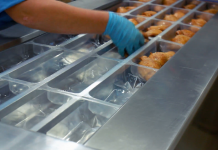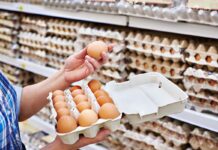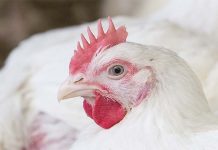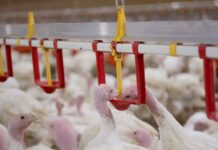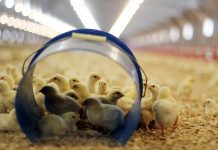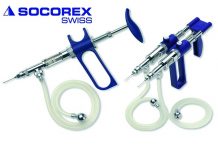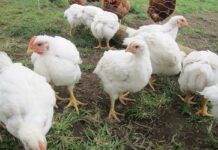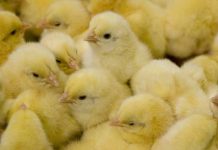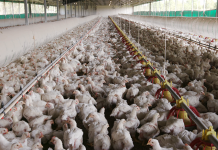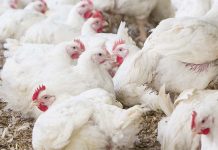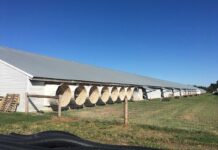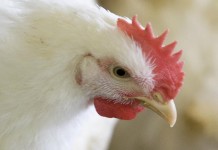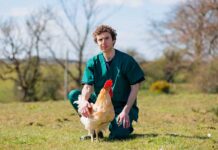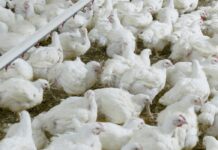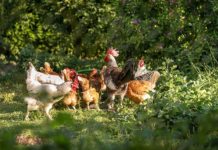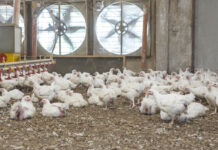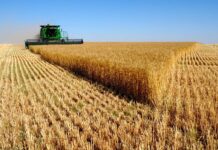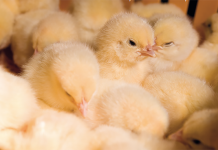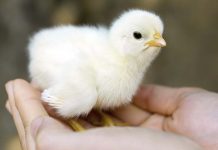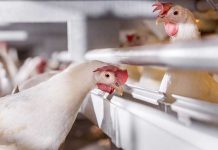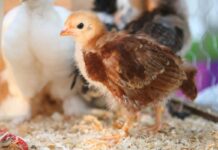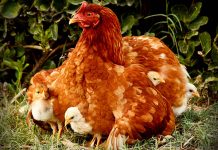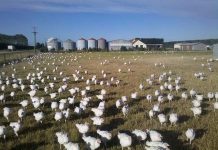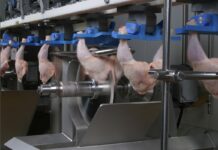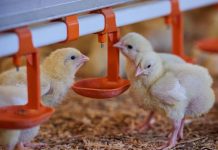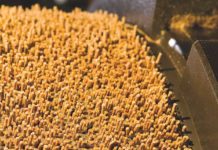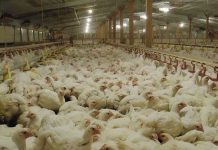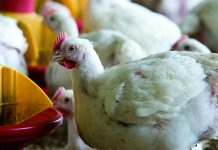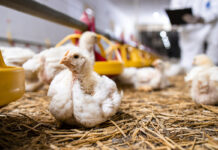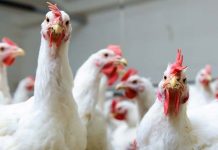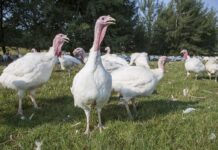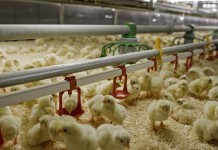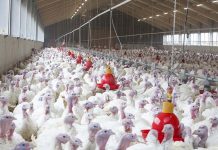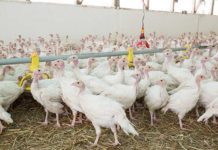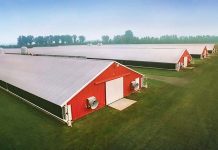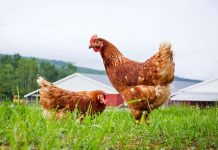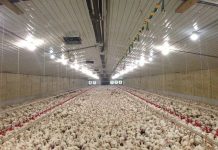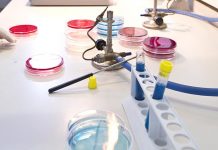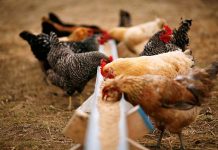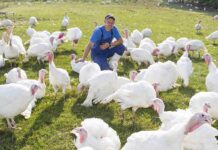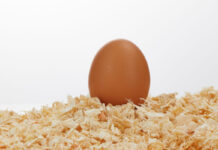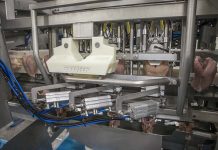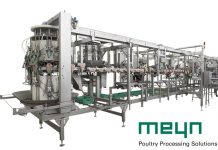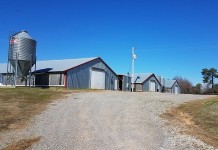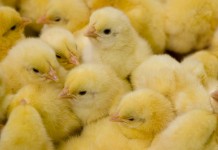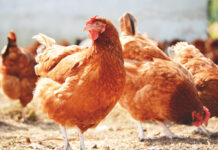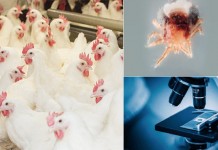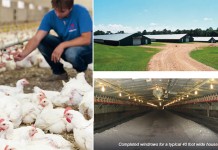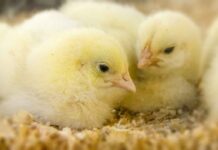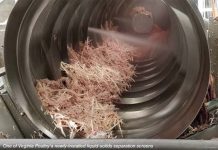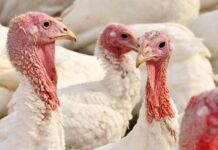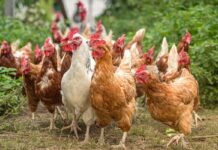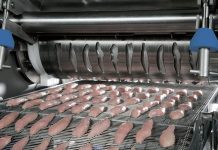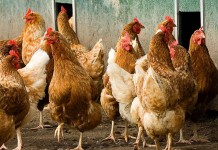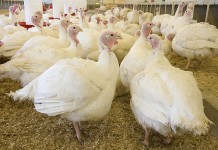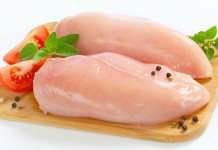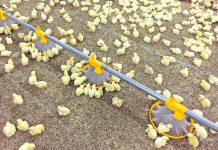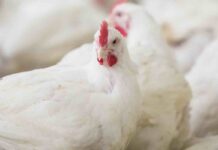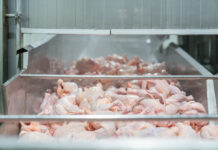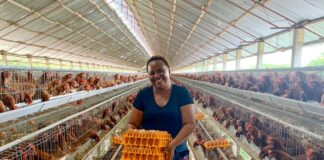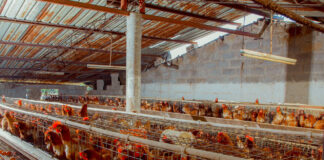Measurement of true ileal calcium digestibility of meat and bone meal for broiler chickens
Currently, there is a move towards the use of digestible phosphorus (P) in diet formulations for poultry due to P excretion into the environment...
New technologies in housing, equipment and computer controls
The poultry housing and equipment industry continues to develop, introducing new technologies in line with trends in modern communications and ventilation systems. As expected...
Testing day-old poults
When poults are received at a farm from the hatchery they should be good quality poults; namely, free from physical defects, actively looking for...
Management best practices: small details can have the big-gest impact
Raising turkeys is equal parts science and art. It involves precise measurement of various factors throughout the life of the flock. It also requires...
Innovative methods for a multidisciplinary risk management in poultry slaughterhouses
The purpose of controls in slaughterhouses is to ensure food safety and quality as well as to monitor animal health and welfare.
Control efficiency can...
Better for birds, the earth, and you: Kipster’s egg
In the United States, as of March 2024, 40% of eggs produced are cage-free. While the cage-free movement has gained momentum worldwide, one company...
Improving poultry products safety
The research is part of the Association’s comprehensive research program encompassing all phases of poultry and egg production and processing.
Dr. Hong Zhuang at...
New animal welfare labelling system
The conclusions of the animal welfare labelling subgroup of the Commission’s Animal Welfare Platform were released. Copa and Cogeca welcomes the main conclusions of...
The importance of gut microbiota in chickens
Recent expansion in knowledge about the influence of microbiota on health and disease started a major research revolution in the area. Intestinal systems of...
Researchers investigate the characteristics of Turkey Hepatitis Reovirus
USPOULTRY and the USPOULTRY Foundation announced the completion of a funded research project at the University of Minnesota in which researchers investigated the characteristics of Turkey...
Effectiveness of a double choice test to assess dietary taste preferences in broilers
Investigations into the taste system of broilers can help to improve poultry feeding strategies. However, a comprehensive study on dietary taste preferences for broilers...
Use of injection syringes in the animal production industry
Animal health is an important factor to consider, as any disease outbreak can potentially have drastic economical consequences. For this reason, planning and preparing...
Artificial structures mitigate simulated adverse pop-hole conditions
There is some evidence that commercial meat chickens prefer to access the range through ‘favoured’ pop-holes; however what makes pop-holes attractive or aversive is...
Is chick yield still a valid reference?
Many hatcheries still use chick yield – chick yield is the average chick weight divided by the average fresh egg weight multiplied by 100...
Research Rules Out Possible Kinky Back Prevention
USPOULTRY and the USPOULTRY Foundation announce the completion of a funded research project at North Carolina State University in Raleigh, N.C., in which researchers...
Case report: histomoniasis in broiler breeder pullets
Histomoniasis, commonly known as blackhead disease, is caused by an anerobic protozoan parasite, Histomonas meleagridis. Histomoniasis affects all gallinaceous birds and turkeys are the...
Managing heat and minimum ventilation systems in the broiler house
When outside temperatures drop and gas prices rise, maintaining the desired inside broiler house air temperature and ventilating to meet air quality needs can...
Broilers perform better with intermittent lighting programs
Roles of certain parts of the digestive tract of chickens seems to have been lost with the evolution of time and commercial practices. Gizzards...
Biodiversity – breeding choice for the markets of today and tomorrow
In this article, Aviagen® Ltd R & D Manager Brendan Duggan discusses the second of Aviagen’s Top 5 Commitments, Biodiversity, and how this commitment...
Best practice in feed management
How innovative thinking and a proactive approach can ensure best practice with feed on broiler farms
In partnership with Cobb, this article examines best practice...
Chicken study probes resistance to food bug
Receiving gut microbes from resistant chickens does not lessen chickens’ susceptibility to bacterium that causes food poisoning.
Susceptible chickens became even more susceptible to Campylobacter,...
Identification of broiler poultry house dust components using chemical and physical analysis
Dust found in poultry housing is a complex substance most likely comprised of a mixture of excreta, feather, feed and bedding material.
M. Ahaduzzaman, L....
Dietary xylanase improves growth performance and cost savings in broiler chickens fed a corn-soybean...
The increased demand to reduce production costs, as well as concerns about the environment, have resulted in pressure on poultry producers to increase dietary...
Biosecurity – practical tips to minimize the human risk of contamination
All poultry operations are under a constant threat from the ever-present enemy of disease and infection. It is imperative in all operations that we...
In ovo injection of oregano essential oil at different pH affects hatchability and post-hatching...
The dynamic complexity of the developing embryo requires the maintenance of differentiated compartments with the capacity to maintain independent environments required to optimise their...
Reducing the environmental impact of egg production via breeding and alternative diet
Egg production has an important role in the global production of food. For decades, we have successfully selected laying hens that efficiently produce animal...
Layer nutrition associated with different production systems
The egg industry continues to grow; in the past this was in cage production, but today’s growth is focused on alternative production systems such...
Rethink the golden rules of incubation
Your incubation results might be affected by a lack of accuracy in the rules you’re applying. The rules of incubation have been derived from...
How to improve hen fertility
Following specific procedures to increase hen fertility will not eliminate drops in fertility, but it may also reduce the need to trouble-shoot breeder flocks.
Artificial...
Easy-entry poultry cut-up automation
In today’s tough times, there are various reasons for poultry processors to reconsider the number of operatives in their cut-up department and think about...
Holistic view of intestinal health in poultry
Intestinal health is necessary to maintain efficient and sustainable gastrointestinal tract (GIT) physiology. The GIT has digestive, absorptive, metabolic, immunological and endocrinological functions.
This means...
Potential to produce poultry feed from food wastes
The annual food waste in Australia is estimated at 7.5 million tonnes
with the majority disposed of in landfills. This not only
causes significant economic loss...
Hatching for egg quality
Hatching for egg quality implies caring of various factors. The age of the flock, number of storage days and incubation program are typically included...
Genetic evaluation of body weight and tibia resistance in broilers
In this study, genetic parameters of important traits related to body weight and bone resistance were investigated in a paternal broiler line. Data from...
The effects of a multi-enzyme and Bacillus probiotic combinations on calcium and phosphorus digestibility...
450 day-old male Ross 308 chicks were randomly allocated to 3 dietary treatments with 6 replicate pens per treatment and 25 birds per pen....
Researchers use laser for broiler house enrichment
USPOULTRY and the USPOULTRY Foundation announce the completion of a funded research project at Iowa State University in Ames, Iowa, in which researchers used...
Use of comparative genomics to identify vaccine candidates for Campylobacter Jejuni
Interventions to control and reduce the incidence of Campylobacter jejuni colonization in poultry is important in order to reduce the burden of foodborne illness in humans....
Spirulina platensis Algae, a novel poultry feed additive
Identifying alternative replacements for soybean meal in a high quality and reasonable price is of importance in poultry production and physiological parameters. Spirulina platensis...
Management of precise broiler production in farm level and technology usage
Farming broilers today has some very real challenges, namely birds are reaching their kill weights quicker, the profits from farming chicken are under pressure,...
Development of Multilocus sequence typing (MLST) for Mycoplasma gallisepticum
Mycoplasma gallisepticum (MG) is the most pathogenic avian mycoplasma species. It affects commercial, non-commercial poultry and wild birds. Current MG sequence typing methods rely...
Protozoal management in turkeys
The two turkey protozoa that cause significant animal welfare and economic distress include various Eimeria species of coccidia and Histomonas meleagridis. For coccidia, oral...
Gaining a better understanding of incubation in a hatchery
The contemporary hatchery is a complex installation. The core part is the incubators, supported by the devices that facilitate their function and auxiliary machines...
How to reduce antibiotics in broiler production?
There is an increased awareness recently in relation to the sensible use of antibiotics within poultry and livestock production. When looking at broiler production,...
The value of digestibility coefficients and protein
At all times and for all human cultures animal protein took an important part of nutrient supply and has been always of a high...
Footpad dermatitis in market turkey hens. Bird density and bedding material relationships
Lameness
and poor footpad condition can be major issues for meat-type poultry resulting
in their decreased well-being and decreased productivity. A large body of
research exists for...
Use of multiple strains of infectious bronchitis vaccines to induce protection against new IB...
USPOULTRY (www.uspoultry.org.) and the USPOULTRY Foundation announced the completion of a funded research project at the University of Delaware in Newark, Del., in which researchers found...
Feeding broilers of the future
The only way to maintain production is to improve the understanding of precision nutrition so that producers can feed broilers with low or no...
Efficacy and economics of oral fluralaner for the treatment of northern fowl mites in...
Once mites are observed in one area of the barn they tend to progressively spread to the whole barn and subsequently to the next...
The trifecta for a sustainable production
To meet the needs of an additional three billion people over the next 35 years and to prevent further escalation of global poverty, agricultural production must double during this time. In meeting the increased demand for food, the interdependence between water, food and energy will become more evident and highlight resource insecurities.
How to improve indoor air quality in poultry housing
USPOULTRY and the USPOULTRY Foundation announce the completion of a funded research project at Iowa State University in Ames, Iowa, in which researchers provided...
Interrupting cholesterol pathway reduces Marek’s disease spread
In a new discovery, scientists from The Pirbright Institute confirm that cholesterol production and transport play a crucial role in how Marek’s disease virus...
Isolation, bioactivity and applications of sulfated polysaccharides from poultry by-products
The broiler chicken meat processing industry produces a large amount of poultry byproducts rich in connective tissue (i.e. keel cartilage, skin, and bone residues),...
A cost-effective solution to partially replace vitamin E
Oxidative imbalance can reduce animal productivity. If severe, it can lead to inflammation, reduced immune function and increased susceptibility to disease. Livestock producers typically...
How does your turkey grow?
Predicting how a turkey flock might grow under different nutritional and environmental conditions is a question of interest to everyone involved in turkey production...
What is the influence of nutrition and management on egg weight?
Managing egg weight is important for farmers and can greatly vary depending on market demand. Obtaining an egg size in line with market demand...
Taking portioning to a new era, Marel I-Cut 122 dual-lane high-speed portion cutter for...
I-Cut 122 Portion Cutter by Marel combines the highest levels of accuracy, throughput and reliability with new, innovative software.
The dual-lane I-Cut 122 has been...
Marel Poultry’s AMF-i sets the world’s benchmark
Marel Poultry’s AMF-i innovating the poultry processing. Breast cap deboning is an extremely important stage in any poultry processing plant. During this process, end...
Research reveals method to improve Escherichia coli vaccines
A funded research project at the University of Georgia in Athens, Ga. was completed, in which researchers revealed a method to improve Escherichia coli...
Meyn: a look inside the market for deboning and deskinning
The poultry processing market is still on the road to growth. A CAGR of 4.7% by 2020 in USA alone is evidence of the...
Research shows practical method to reduce litter moisture
USPOULTRY and the USPOULTRY Foundation announce the completion of a funded research project at the University of Georgia in Athens, Georgia, in which researchers...
Using sunflower meal in broilers with the addition of a carbohydrase complex
Sunflower seeds are extensively grown for oil production for human consumption. Therefore, a great amount of sunflower meal becomes available for use in feed...
Managing coccidiosis in birds raised without antibiotics
For poultry producers to make a profit they must have healthy, uniform sized birds, make sure there are no real or assumed human health...
The effects of in-ovo feeding
In-ovo feeding is a key issue in poultry. The embryonic and immediate post hatch developmental period represents a significant phase in attaining quality broiler...
How can the poultry industry become carbon neutral?
Following the Paris climate agreement (COP21), countries and agricultural supply chain companies are setting targets towards net zero greenhouse gas (GHG) emissions by 2050....
Characterizing litter mite communities. Applications of DNA barcoding for management strategies
The use of DNA barcoding can facilitate rapid biodiversity assessments of fastidious taxa - litter mite communities - by delineating species using molecular operational...
Windrowing properly done
Windrowing litter between flocks has been used commercially since the 1980’s and continues to evolve to meet numerous production challenges. The goal is to...
Informative Processing School in Malaysia
A highly successful four-day processing school was held in Malaysia for Aviagen® personnel to improve their knowledge and understanding of the impact of the...
The effect of hot and cold hatcher temperature profiles on hatchability and chick quality
An eggshell temperature of 100°F (37.8°C) is widely accepted as optimal for embryonic development from the start of incubation up until transfer time. Eggshell...
Reducing water usage in turkey processing
Virginia Poultry recently installed several liquid/solids separation screens for reducing water usage in its turkey feather and offal processing. The two new primary and...
Boosting the cell-mediated immunity in chickens post-hatch via pre-hatch delivery of nucleic acids
Respiratory virus infections such as Avian Influenza, infectious laryngotracheitis and infectious bronchitis lead to high morbidity and mortality in chickens globally.
Given the limitations...
Cochlosoma anatis in turkeys
A funded research project at North Carolina State University in Raleigh, N.C. evaluated the pathogenicity of Cochlosoma anatis. The research was made possible in...
Management of ectoparasites in cage-free housing systems
As cage-free systems become more frequent in poultry production, we are forced to evaluate how pest control measures should adapt to ensure efficacy.
The...
Woody breast in the poultry meat industry
In the U.S., poultry is widely popular by consumers and is the top protein consumed. In the last decade along with improvements in growth...
Visual identification of potential feather pecking
Feather pecking behaviour is common in floor-housed laying hens a behavior, which is positively associated with developing feather pecking habits.
It has been suggested that...
Turkey breeding – Where from, Where to? – Domestication of animals was a major...
All species of today’s domestic plants and animals followed an analogous pattern of multi-generational change influenced by humans. The modern populations of turkeys followed...
Water holding capacity in poultry breast meat
Water holding capacity (WHC) is defined as the ability of meat to hold its inherent and added moisture during fabrication, processing, and storage.
Low protein diets in broilers
Some recent research at the Arkansas Agriculture Experiment Station Poultry Research Farm has been focused on low protein diets in broilers. Many nutritionists rely...
Effects of beta glucans in poultry health and nutrition
Immune modulators such as beta glucans have today a major role in poultry production.
The poultry production industry has seen astonishing improvements over the past...
Safeguarding processing yield across the primary process
The processing plant is the epicenter of a poultry processing company for being its only utility-generating area, as all the others are cost-generating centers,...
Advantages and disadvantages of Coccidiosis control programs in poultry
Coccidiosis is a protozoan economic disease of poultry, in which around 80% of losses are due to mortality, reduced weight gain, inefficient feed conversion,...


